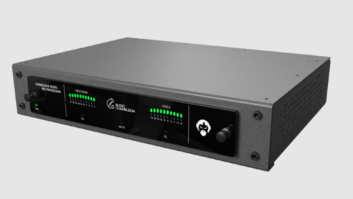
This article originally appeared in TV Technology.
In the last two Inside Audio columns (Exploring Audio Control Room Acoustics, Audio Control Room Acoustics, Part 2) we looked at some of the reasoning behind the design of high-end audio control rooms. This time we’ll take a look at what can be done when space for the control room is inappropriate and the budget inadequate. How do we create a decent control room when the space is too small; the floor is raised; the space above the drop ceiling is open; and the walls are as thin as those of a cheap motel?
We’ll focus on four areas that will help overcome these issues and deliver a room that should function properly for professional audio work, and each can be adapted to fit the available budget. The information presented here has been gleaned through experience building audio control rooms in small spaces that now produce high-quality audio for television.
ISOLATE THE SPACE
Controlling sound transmission into the room is essential so the audio engineer can be certain that what they hear is direct sound from the speakers and not from exterior noise sources. We first must make sure the walls have enough mass to act as a transmission barrier and that all penetrations are sealed.
Walls need to span from the floor above to the floor below and should be extended if they don’t. Single-layer walls require one or two additional layers of sheetrock to increase the wall’s mass. MDF can be used for the top layer instead of sheetrock to add mass without stealing space from the interior footprint.
Ideally, all adjacent room walls will receive the same treatment as the interior walls to minimize sound transmission between the rooms and to allow the sealed air space between the walls to act as an additional barrier. All openings, including those above ceilings and below raised floors, should be closed and patched, then sealed with an acoustic sealant or multiple layers of caulk.
If the budget doesn’t support the purchase of an acoustical door, then a heavy solid-core door with high-quality, properly adjusted acoustic seals will work as a less-effective substitute. It is best to purchase a real acoustical window if one is required, but if that is budget-prohibitive then an add-in acoustical window kit or, at a minimum, a double-pane industrial grade window can be used.
CONTROL STANDING WAVES AND MODES
Standing waves and modes are worse in small spaces because they are concentrated into just a handful of frequencies instead of being spread across a larger range as they would in large rooms. Modes are a characteristic of room dimensions, while standing waves are stationary modes below 300 Hz caused by reflections from the room’s boundaries.
A simple calculation for determining room modes is the formula 1130/2d=f. This breaks down as the speed of sound (1130 ft/s), divided by a single dimension of the room times two, equaling the frequency of the mode.
We need to calculate the fundamentals for height, length and width; then the harmonics by multiplying the fundamentals by two, three, etc. Charting these modes (Fig. 1) allows us to see which frequencies will cause problems in the room. Rectangular rooms generally give the best performance while cube-shaped rooms contain the nastiest modes because height, width and depth dimensions are the same, resulting in identical mode frequencies, all landing at the same location in the room, creating giant modes as well as cancellation of other frequencies.
Fig. 1
With a limited budget and no way to expand the space, our options for dealing with modes are limited. Experiment with placing traps in the corners, rear and front of the room until low frequencies seem under control. A significant concern in small rooms, especially cube-shaped ones, is that the modes and cancellations tend to be worse near the middle of the room; so make sure the mix position is located elsewhere.
CONTROL REFLECTIONS
Reflections interfere with our perception of direct sound from the speakers by summing or canceling some of the direct sound we hear. Mid- and high-frequency reflections are generally the most obvious and can be controlled by removing reflective surfaces near the speakers and placing acoustic absorbing panels on the room’s hard surfaces.
A good way to determine where to begin applying absorption is to stand behind the main speakers and see where they are pointed. Panels should be placed in their initial position then moved, added or removed systematically until reflections are minimized.
Once frequency response at the mix position seems even across the spectrum, panels can be mounted permanently. At this point there should be no need to add more absorption since it may cause the room to sound dead. If additional treatment is desired then diffusion should be used to disperse reflections rather than absorbing them. Placement of traps, absorbers, and diffusors is often more of a process than a one-time event and occasional adjustments may be required.
REMOVE INTERNAL NOISE SOURCES
One frustrating and entirely controllable element of building an audio control room is that, at some point, equipment will get installed and some of it will make noise. Hard drives and fans are typically the worst culprits so, along with CPUs, they should be moved to an equipment room and out of the control room.
Keyboard, video and mouse (KVM) extenders make this relocation of noise-making equipment fairly easy, but they can be expensive. If the budget doesn’t provide for the purchase of KVMs then an acoustic isolation cabinet can be used, or cables may need to be extended out of the room to an adjacent equipment closet.
A successfully built audio control room is one that insures the audio engineer can rely on what they hear while working in it. By focusing on isolation, control and noise elimination we can transform seemingly unusable spaces into effective audio control rooms. Still, it’s most important to listen critically as we make room improvements to help determine whether our changes will improve the room, make no difference or make things worse.
In audio engineering, the right decision often comes down to what we can discern with the most powerful tool in our toolbox, our ears.
Jay Yeary spends his days working for a large media corporation where he has the opportunity to work on audio control room projects of all sizes. He can be reached through TV Technology or via Twitter at @audiojay.












